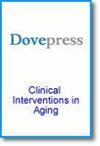心房颤动老年患者的抗凝疗法和虚弱的影响
IF 3.7
3区 医学
引用次数: 0
摘要
研究目的本研究探讨了体弱和非体弱老年非瓣膜性心房颤动(NVAF)患者的抗凝治疗是否安全:出院时,记录了 361 名非瓣膜性心房颤动老年患者(年龄≥ 75 岁)的抗凝方案和虚弱状态。对患者进行了为期 12 个月的随访。终点包括血栓形成、出血、全因死亡和心血管事件:出院时,50.42%的患者体弱,抗凝率为 44.04%。出院时,年龄(OR 0.948,P = 0.006)、阵发性 NVAF(OR 0.384,P <0.001)和出血史(OR 0.396,P = 0.001)与接受抗凝治疗的比例下降有关,而住院期间血栓事件(OR 2.281,P = 0.021)与接受抗凝治疗的比例上升有关。与非体弱患者相比,体弱患者发生缺血性中风(5.33%,3.01%)、出血(P = 0.006)和全因死亡率(P = 0.001)的比例更高。与未接受抗凝治疗的患者相比,接受抗凝治疗的患者发生血栓事件的比例较低(6.99 比 10.98%),发生出血事件的比例较高(20.98 比 12.72%),但发生大出血的风险相当:在老年 NVAF 患者中,出院时的抗凝治疗决定受年龄、出血史、阵发性心房颤动诊断和无血栓形成的影响。体弱患者的出血风险和全因死亡率更高。抗凝治疗往往能降低血栓事件的风险。关键词:老年人、非瓣膜性心房颤动、虚弱、抗凝治疗本文章由计算机程序翻译,如有差异,请以英文原文为准。
Effects of Anticoagulant Therapy and Frailty in the Elderly Patients with Atrial Fibrillation
Objective: This study explored whether anticoagulation is safe for frail and non-frail elderly patients who have nonvalvular atrial fibrillation (NVAF).
Methods: At hospital discharge, the anticoagulant regimen and frailty status were recorded for 361 elderly patients (aged ≥ 75 y) with NVAF. The patients were followed for 12 months. The endpoints included occurrence of thrombosis; bleeding; all-cause death; and cardiovascular events.
Results: At hospital discharge, frailty affected 50.42% of the population and the anticoagulation rate was 44.04%. At discharge, age (OR 0.948, P = 0.006), paroxysmal NVAF (OR 0.384, P < 0.001), and bleeding history (OR 0.396, P = 0.001) were associated with a decrease in rate of receiving anticoagulation, while thrombotic events during hospitalization (OR 2.281, P = 0.021) were associated with an increase. Relative to non-frail patients, those with frailty showed a higher rate of ischemic stroke (5.33% cf. 3.01%), bleeding (P = 0.006) events, and all-cause mortality (P = 0.001). Relative to the group without anticoagulation, in those with anticoagulation the rate of thrombotic events was lower (6.99 cf. 10.98%) and bleeding events were higher (20.98 cf. 12.72%), but the risk of major bleeding was comparable.
Conclusion: In the elderly patients with NVAF, the decision toward anticoagulation therapy at hospital discharge was influenced by age, bleeding history, paroxysmal atrial fibrillation diagnosis, and absence of thrombosis. Frail patients were at greater risk of bleeding and all-cause mortality. Anticoagulation tended to reduce the risk of thrombotic events.
Keywords: elderly, non-valvular atrial fibrillation, frailty, anticoagulation
Methods: At hospital discharge, the anticoagulant regimen and frailty status were recorded for 361 elderly patients (aged ≥ 75 y) with NVAF. The patients were followed for 12 months. The endpoints included occurrence of thrombosis; bleeding; all-cause death; and cardiovascular events.
Results: At hospital discharge, frailty affected 50.42% of the population and the anticoagulation rate was 44.04%. At discharge, age (OR 0.948, P = 0.006), paroxysmal NVAF (OR 0.384, P < 0.001), and bleeding history (OR 0.396, P = 0.001) were associated with a decrease in rate of receiving anticoagulation, while thrombotic events during hospitalization (OR 2.281, P = 0.021) were associated with an increase. Relative to non-frail patients, those with frailty showed a higher rate of ischemic stroke (5.33% cf. 3.01%), bleeding (P = 0.006) events, and all-cause mortality (P = 0.001). Relative to the group without anticoagulation, in those with anticoagulation the rate of thrombotic events was lower (6.99 cf. 10.98%) and bleeding events were higher (20.98 cf. 12.72%), but the risk of major bleeding was comparable.
Conclusion: In the elderly patients with NVAF, the decision toward anticoagulation therapy at hospital discharge was influenced by age, bleeding history, paroxysmal atrial fibrillation diagnosis, and absence of thrombosis. Frail patients were at greater risk of bleeding and all-cause mortality. Anticoagulation tended to reduce the risk of thrombotic events.
Keywords: elderly, non-valvular atrial fibrillation, frailty, anticoagulation
求助全文
通过发布文献求助,成功后即可免费获取论文全文。
去求助
来源期刊

Clinical Interventions in Aging
GERIATRICS & GERONTOLOGY-
CiteScore
6.20
自引率
2.80%
发文量
193
期刊介绍:
Clinical Interventions in Aging, is an online, peer reviewed, open access journal focusing on concise rapid reporting of original research and reviews in aging. Special attention will be given to papers reporting on actual or potential clinical applications leading to improved prevention or treatment of disease or a greater understanding of pathological processes that result from maladaptive changes in the body associated with aging. This journal is directed at a wide array of scientists, engineers, pharmacists, pharmacologists and clinical specialists wishing to maintain an up to date knowledge of this exciting and emerging field.
 求助内容:
求助内容: 应助结果提醒方式:
应助结果提醒方式:


